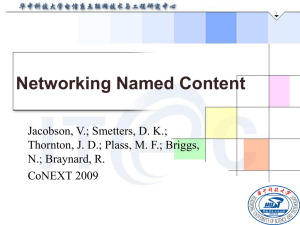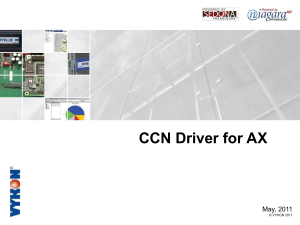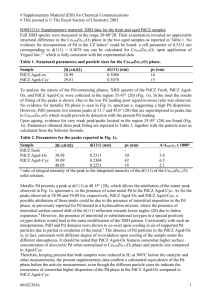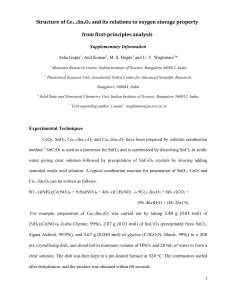grl53794-sup-0001-s03
advertisement
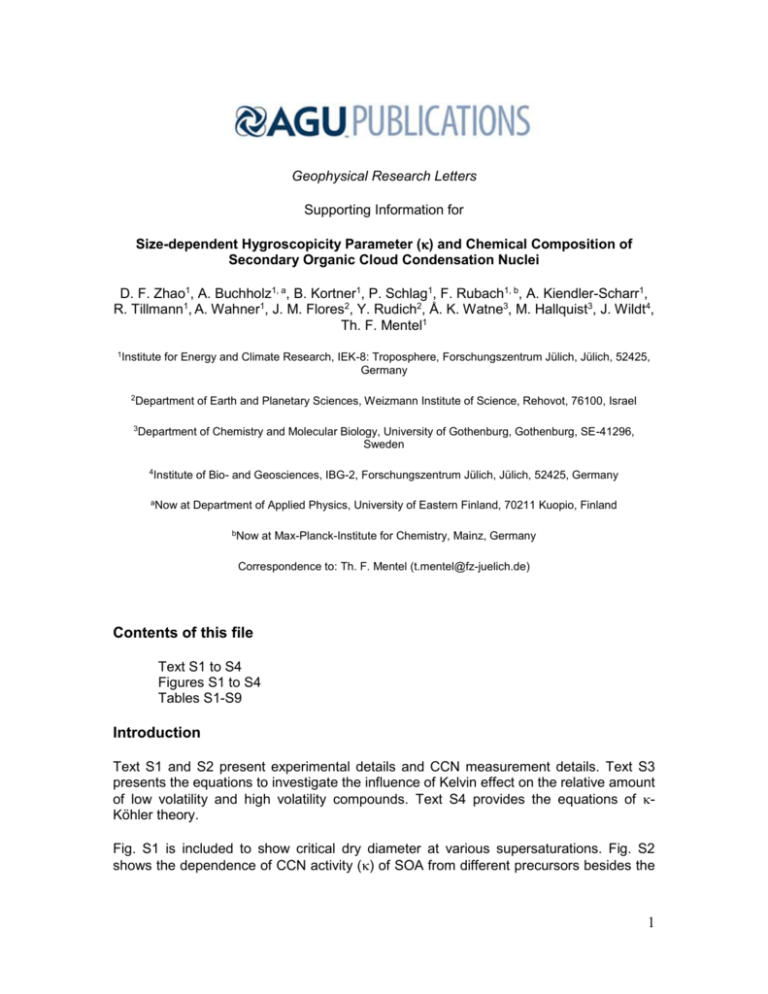
Geophysical Research Letters Supporting Information for Size-dependent Hygroscopicity Parameter () and Chemical Composition of Secondary Organic Cloud Condensation Nuclei D. F. Zhao1, A. Buchholz1, a, B. Kortner1, P. Schlag1, F. Rubach1, b, A. Kiendler-Scharr1, R. Tillmann1, A. Wahner1, J. M. Flores2, Y. Rudich2, Å. K. Watne3, M. Hallquist3, J. Wildt4, Th. F. Mentel1 1Institute for Energy and Climate Research, IEK-8: Troposphere, Forschungszentrum Jülich, Jülich, 52425, Germany 2Department of Earth and Planetary Sciences, Weizmann Institute of Science, Rehovot, 76100, Israel 3Department 4Institute aNow of Chemistry and Molecular Biology, University of Gothenburg, Gothenburg, SE-41296, Sweden of Bio- and Geosciences, IBG-2, Forschungszentrum Jülich, Jülich, 52425, Germany at Department of Applied Physics, University of Eastern Finland, 70211 Kuopio, Finland bNow at Max-Planck-Institute for Chemistry, Mainz, Germany Correspondence to: Th. F. Mentel (t.mentel@fz-juelich.de) Contents of this file Text S1 to S4 Figures S1 to S4 Tables S1-S9 Introduction Text S1 and S2 present experimental details and CCN measurement details. Text S3 presents the equations to investigate the influence of Kelvin effect on the relative amount of low volatility and high volatility compounds. Text S4 provides the equations of Köhler theory. Fig. S1 is included to show critical dry diameter at various supersaturations. Fig. S2 shows the dependence of CCN activity () of SOA from different precursors besides the 1 one in the main manuscript. Fig. S3 shows the dependence of SOA chemical composition in additional experiment. Fig. S4 shows the CCN calibration data. Table S1 shows the summary of the experiments. Table S2 and S3 shows the theoretical CCN data and experimental CCN data of (NH4)2SO4 for calibration. Table S4 shows the summary of the previous studies of SOA from α-pinene. . Table S5, S6, S7, S8, S9 present the data in Figure 1, 2a, 2b, 3 and 4 of the main manuscript, respectively. Text S1. Experimental details The experiments were carried out in the outdoor atmosphere simulation chamber SAPHIR, a 270 m3 double-wall Teflon chamber of cylindrical shape at the Forschungszentrum Jülich, Germany (surface to volume ratio: 0.88 m-1). The chamber uses natural sunlight as light source and is equipped with a louvre system which can be used to simulate dark processes when closed. A continuous flow 7-9 m3 hr-1 of synthetic air keeps the chamber at a slight overpressure of ~50 Pa and compensates for the losses by sampling air of various instruments. The OH radical comes from photolysis of HONO emitted by the photolytic process of Teflon wall. Typical OH concentration is several 106 molecules cm-3 for the experiments in this study, which is close to the ambient daytime OH level. The details of the chamber have been previously described [Bohn et al., 2005; Rohrer et al., 2005]. For the experiments described here, the chamber was equipped with instrumentation for gas phase and particulate phase characterization, and for measuring chamber parameters such as temperature, relative humidity, flow rate and photolysis frequencies. In a typical experiment, the starting RH was 75% and can vary between 30% and 75% over the whole experiment due to the diurnal temperature change and the dilution by compensation flow. The typical peak J(O1D) measured from a spectral radiometer is about 1.510-5 s-1. The details of each experiment are summarized in Table S1. Text S2. Detailed description of CCN activation measurement The setup of CCN activation measurement consisted of a cloud condensation nuclei counter (CCNC, Droplet Measurement Technique, USA) and a condensation particle counter (CPC3786, TSI, USA), which were operated in parallel after a differential mobility analyzer (DMA). This method, also known as Scanning Mobility CCN analysis [Moore et al., 2010], has been successfully used previously [Asa-Awuku et al., 2008; AsaAwuku et al., 2009; Asa-Awuku et al., 2010; Buchholz, 2010; Engelhart et al., 2008; Engelhart et al., 2011; Padro et al., 2007; Zhao et al., 2010; Zhao et al., 2015]. Particles 2 first passed through the DMA and the outgoing flow was split to CPC and CCNC to measure simultaneously the concentrations of condensation nuclei (CN) and CCN, respectively. Particles with diameters (Dp) between 10 nm and 500 nm were studied by scanning the DMA while the supersaturation (SS) remained constant. In each scan, for each particle size class, the activated fraction (af, CCN/CN) was calculated from the measured CCN and CN concentrations after multi-charge correction. The fraction of multiple charged particles was calculated using the measured size distribution for each size class according to a natural charge distribution [Wiedensohler, 1988]. After multicharge correction, af for the single charge particles was obtained as a function of Dp, which was fitted with a cumulative Gaussian error function [Rose et al., 2008]. The critical dry diameter (Dcrit) at a given SS is determined from the turning point of the function. At each supersaturation (SS), three full size scans were made, and four to five different supersaturations in the range of 0.1%-1% were used with the exact SS depending on the particle size distribution. The time matching between the CCN and the CPC was carefully done using a method similar to Moore et al. [2010]. The time delay between the CCN and CPC was measured by changing the particle concentration immediately via an abrupt change of particle size (DMA voltage) of poly dispersed (NH4)2SO4 aerosol. In the data analysis, the raw SMPS data (time resolution 0.1 s) was used. The exact delay time between the CCN and the CPC was obtained by adjusting the delay time (in the step of 0.1s) to achieve the optimal overlap of the larger size parts of size distribution between CCN and CPC which includes an up scan and down scan. This method provides an accuracy of 0.1s for the time delay. In addition, the tubings from DMA to CCN and CPC were kept constant. For each SS the average Dcrit of the three scans was obtained. The SS was calibrated using theoretical SS vs. Dcrit of (NH4)2SO4 particles. The theoretical values from Rose et al. [2008] (OS1 data set, c.f. Table S2) were used. Typical calibration data are shown in Table S3 and Figure S4. From Dcrit at given SS, the hygroscopicity parameter was calculated using the method in Petters and Kreidenweis [2007]. Text S3. Equations related to the influence of Kelvin effect on the relative amount of low volatility and high volatility compounds According to the Raoult law, 𝐶𝑖,𝑔 = 𝑥𝑖,𝑙 𝐾𝑒 𝐶𝑖0 , (S1) where Ci,g is the gas phase concentration of species i, xi,l is the liquid phase molar fraction of species i, Ci0 is the saturated concentration of species i and Ke is the Kelvin effect term. 3 4𝑉 𝜎 𝐾𝑒 = exp(𝑅𝑇𝐷𝑙 ), (S2) 𝑝 Where Vl is the partial molar volume (assuming different species have the same partial molar volume), is the surface tension, R is the gas constant, T is the temperature and Dp is the diameter of the particle. Xi,l can be obtained from the Ci,l, the liquid phase concentration of species i, and Ct, the total molar concentration of all species in the liquid phase, 𝑥𝑖,𝑙 = 𝐶𝑖,𝑙 . 𝐶𝑡 (S3) Substituting Eq. S3 into S1 and rearranging, one can get 𝐶𝑖,𝑔 𝐶𝑖,𝑙 = 𝐶𝑖0 𝐶𝑡 𝐾𝑒 . (S4) Using Ci,t, total concentration of species i in the gas and particle phase, one can get 𝐶𝑖,𝑔 = 𝐶𝑖,𝑡 − 𝐶𝑖,𝑙 . (S5) Substituting Eq. S5 into S4 and rearranging, one can get 𝐶𝑖,𝑙 = 𝐶𝑡 𝐶𝑖0 𝐾𝑒 +𝐶𝑡 𝐶𝑖,𝑡 (S6) Similarly, for species j, 𝐶𝑗,𝑙 = 𝐶𝑖,𝑙 𝐶𝑗,𝑙 = 𝐶𝑡 𝐶𝑗0 𝐾𝑒 +𝐶𝑡 𝐶𝑡 𝐶0 𝐾 𝑖 𝑒 +𝐶𝑡 𝐶𝑡 𝐶0 𝑗 𝐾𝑒 +𝐶𝑡 𝐶𝑗,𝑡 (S7) 𝐶𝑖,𝑡 (S8) 𝐶𝑗,𝑡 After rearrangement, one can get 𝐶𝑖,𝑙 𝐶𝑗,𝑙 𝐶0 = 𝐶𝑗0 (1 + 𝑖 (𝐶𝑖0 −𝐶𝑗0 )𝐶𝑡 ) 𝐶𝑖0 𝐶𝑗0 𝐾𝑒 +𝐶𝑗0 𝐶𝑡 )∙ 𝐶𝑖,𝑡 𝐶𝑗,𝑡 (S9) Assuming Ci0>Cj0, i.e., species i is more volatile than species j, when particle size decreases, Ke increases and Ci,l/Cj,l decreases. This means that small particles have relatively more low volatility compounds. Text S4. Equations related to -Köhler theory Petters and Kreidenweis [2007] proposed the theory to parameterize CCN activity data using . is defined in the following equation. 1 𝑉𝑠 = 1+𝜅 𝑎𝑤 𝑉𝑤 aw, Vs, and Vw is the water activity, volume of solute and volume of water in the activated droplet, respectively. The following equation is derived in the -Köhler theory. 4 𝐷3 − 𝐷𝑑3 4𝑀𝑤 𝜎𝑠𝑜𝑙 𝑆= 3 exp ( ) 𝑅𝑇𝜌𝑤 𝐷 𝐷 − 𝐷𝑑3 (1 − 𝜅) S: saturation ratio, S=SS+1; D: droplet diameter; Dd: dry particle diameter; Mw: molecular weight of water; sol: surface tension of droplet solution; w: density of water. R: gas constant (8.314 J mol-1 K-1) T: temperature. 5 200 Dcrit (nm) 150 100 50 0.0 0.2 0.4 0.6 0.8 1.0 SS (%) 0 0 2 4 6 Time (h) 8 10 Figure S1. (a) Critical diameter (Dcrit) of SOA formed by α-pinene photooxidation at various supersaturations (SS) for the experiment shown in Fig. 1 (the gray shaded area indicates the dark period). Supersaturation corresponded to Dcrit. 6 0.25 A 0.25 10 8 0.20 6 0.15 4 8 2 0.10 Time (h) 4 10 0.20 Time (h) 6 0.15 B 2 0.10 0 0 0.05 0.05 0.00 0.00 0 50 100 150 200 250 0 50 100 150 Dcrit (nm) 0.25 200 250 300 Dcrit (nm) C 0.25 10 8 2 0.10 6 0.15 4 Time (h) 4 8 0.20 Time (h) 6 0.15 10 0.20 D 2 0.10 0 0 0.05 0.05 0.00 0.00 0 50 100 150 Dcrit (nm) 200 250 0 50 100 150 200 250 Dcrit (nm) Figure S2. CCN activity of SOA represented by hygroscopicity parameter as a function of critical diameter (Dcrit). Particles were generated by photooxidation of various precursors: (a) direct boreal tree emissions, (b) monoterpene (α-pinene/limonene=1, molar ratio), (c) toluene, (d) mixture of monoterpene (α -pinene/limonene=1, molar ratio) and toluene. At the same time of photochemical aging, there was a trend of smaller particles having a higher hygroscopicity () for all systems. The dash lines are only for guiding the eyes. 7 0.12 0.22 f44 ff43 0.20 0.08 0.18 0.06 0.16 0.04 0.14 0.02 0.12 f43 f44 0.10 50 100 150 200 250 300 Dpg (nm) Figure S3. f44 of SOA from the photooxidation of monoterpene (α-pinene:limonene=1:1, molar ratio) and xylene-d10 mixture as a function of particle geometric diameter (Dpg). Dpg is derived from the vacuum dynamic diameter of AMS divided by particle density. f44 decreased with particle size while f43 increased with size. The dashed line is only for guiding the eyes. 8 2 Theoretical value (Rose et al. 2008) Calibrated SS 1 9 8 7 SS(%) 6 5 4 3 2 0.1 9 8 2 3 4 5 6 7 8 Dcrit (nm) 9 2 100 (a) 1.0 SS theoretical (%) 0.8 y=0.8303x+0.0022 0.6 2 R =0.9993 0.4 0.2 0.0 0.0 0.2 0.4 0.6 SS set (%) 0.8 1.0 (b) Figure S4. (a) Theoretical values of SS vs. Dcrit of (NH4)2SO4 particles used for CCN calibration (solid line, c.f. Table S2) from Rose et al. [2008] (OS1 data set) and one typical (NH4)2SO4 calibration data in this study (red cross for the data after calibrated with theoretical data, c.f. Table S3). (b) The relationship between the theoretical SS and set SS (c.f. Table S3). 9 Experiment SOA precursor No. 1 -pinene 2 Monoterpene 3a 4 5 6 7 a VOC (ppb) O3 added(ppb)b -pinene (40) 160 -pinene (48), limonene (48) monoterpene (0.6), sesquiterpene (8.1), Plant emissions stress emissions (4.7), others (2.2) Toluene toluene (85) Xylene Xylene (30) Monoterpene/toluene -pinene (4), limonene (4), toluene (85) Monoterpene/pα-pinene (42), limonene (42), p-xylene-d10 xylene-d10 (90) Experiment description 200 Photooxidation & ozonolysis Photooxidation 82 Photooxidation 0 0 60 Photooxidation Photooxidation Photooxidation 200 Photooxidation : The experiment was done in the JPAC chamber and all the other experiments were done in the SAPHIR chamber. b : In the experiments #2, 3, 6, 7, O3 was added to the chamber immediately before the roof was opened. In the experiment #1, O3 was first added to the chamber to initiate ozonolysis and after around 5 h, the roof was opened to start photooxidation. Table S1. Summary of the experiments in this study. 10 Dcrit (nm) 20 30 40 50 60 70 80 90 100 110 120 130 140 150 160 170 180 190 200 SS (%) 1.843682 0.968073 0.615428 0.43389 0.326443 0.256822 0.208739 0.173924 0.147775 0.127551 0.111538 0.098604 0.087979 0.079131 0.071663 0.065256 0.059825 0.055065 0.050907 Table S2. Theoretical values of SS~Dcrit of (NH4)2SO4 particles used for CCN calibration in this study (from Rose et al. 2008, OS1 data set). SS set (%) Dcrit (nm) 0.1 0.15 0.3 0.6 0.9 138.4 112.2 70.8 46.5 35.1 SS_theoretical (%) 0.0897 0.1242 0.2541 0.4890 0.7560 Table S3. Typical (NH4)2SO4 calibration data. 11 Oxidation condition Source depedencea value [VanReken et al., 2005] -1b 0.014-0.091e Ozonolysis [Hartz et al., 2005] [Prenni et al., 2007] x 0 0.028-0.229f 0.1 Ozonolysis Ozonolysis [Engelhart et al., 2008] x 0.11-0.14g Ozonolysis [Duplissy et al., 2008] [Wex et al., 2009] x -1 0.09-0.12 0.1±0.04 Photooxidation Ozonolysis [Juranyi et al., 2009] 0c 0.091±0.01 Photooxidation [Massoli et al., 2010] Frosch [Frosch et al., 2011] [Lambe et al., 2011a] [Lambe et al., 2011b] x 1 x x 0.13-0.24d 0.06-0.16d 0.12-0.23d 0.12-0.18 Photooxidation Photooxidation Photooxidation Photooxidation was not reported. derived from the data decreases with SS. was not reported. does not depend on SS. was not reported and no data on SS dependence available. No data on SS dependence available. decreases with increasing SS. does not depend on SS. But Dcrit only covers >100 nm. No data on SS dependence available. Smaller at larger sizes. No data on SS dependence available. No data on SS dependence available. [Alfarra et al., 2013] x 0.10-0.17 Photooxidation No data on SS dependence available. Findings Setup CIT 28 m3 chamber CMU 103 chamber UCR 7m3 chamber CMU 12 m3 chamber PSI 27m3 chamber 12L flow reactor PSI 27m3 chamber Aerosol flow reactor PSI 27m3 chamber 15L PAM flow reactor 15L PAM flow reactor Univ. Manchester 18m3 chamber Table S4. Summary of the previous studies on the CCN activity of SOA from α-pinene. : “0” means does not depend on supersaturation (SS). “-1” means decreases with increasing SS. “1” means increases with increasing SS. “x” means that author did not investigate or report the dependence of on SS. b : was not reported, but SS~Dcrit data was available to derive . c : Dcrit only covers the size range of >100 nm and author stated that “note that they (dependence) might appear at sizes smaller than the ones measured here.” d : Values are read from the figures in the literature. e : was not reported in the original paper. here was from Petters and Kreidenweis [2007]. f : was not reported in the original paper. here was from Petters and Kreidenweis [2007]. g : was not reported in the original paper. here was from [Engelhart et al., 2011]. a 12 Time 1.8 2.2 2.4 2.6 3 3.2 3.4 3.6 4 4.2 4.4 4.6 5 5.2 5.4 6 6.2 6.4 7 7.25 7.45 7.65 8.05 8.25 8.45 9.05 9.25 9.45 SS 0.83 0.33 0.50 0.67 0.17 0.33 0.50 0.67 0.17 0.33 0.50 0.67 0.17 0.33 0.50 0.17 0.33 0.50 0.17 0.33 0.42 0.50 0.17 0.33 0.42 0.17 0.33 0.42 Dcrit (nm) 48.4 103.1 74.1 54.8 190.0 101.7 74.3 55.8 185.8 100.1 73.6 55.1 178.7 97.5 72.3 173.3 97.7 72.4 173.6 94.3 80.1 69.0 158.7 89.5 77.0 159.2 93.1 76.1 0.16 0.10 0.12 0.17 0.07 0.11 0.12 0.16 0.07 0.11 0.13 0.17 0.08 0.12 0.13 0.09 0.12 0.13 0.09 0.14 0.14 0.15 0.11 0.16 0.16 0.11 0.14 0.17 _stdev 0.015 0.002 0.005 0.027 0.006 0.003 0.006 0.018 0.011 0.002 0.003 0.019 0.003 0.006 0.007 0.005 0.005 0.006 0.011 0.003 0.010 0.001 0.003 0.006 0.009 0.003 0.006 0.009 Table S5. Data in Figure 1 of main manuscript 13 Dpg (nm) 73.1 79.8 86.9 94.3 102.1 110.2 118.6 127.4 136.5 146.0 155.9 166.1 176.7 187.7 f43 0.156 0.150 0.147 0.156 0.152 0.144 0.150 0.146 0.145 0.153 0.151 0.147 0.155 0.169 f43_ 0.024 0.006 0.010 0.008 0.006 0.004 0.005 0.006 0.003 0.004 0.016 0.008 0.006 0.003 f44 0.092 0.082 0.084 0.074 0.078 0.082 0.074 0.077 0.075 0.064 0.068 0.076 0.062 0.052 f44_ 0.010 0.015 0.012 0.015 0.003 0.002 0.003 0.003 0.003 0.008 0.004 0.019 0.029 0.004 Table S6. Data in Figure 2a of the main manuscript 14 Dpg (nm) 94.8 108.9 124.1 140.4 157.8 176.5 196.4 217.5 240.0 263.7 288.7 f43 0.184 0.186 0.191 0.190 0.191 0.194 0.194 0.197 0.201 0.200 0.202 f43_ 0.009 0.012 0.007 0.007 0.005 0.004 0.004 0.005 0.008 0.005 0.010 f44 0.067 0.058 0.053 0.055 0.056 0.050 0.048 0.048 0.043 0.046 0.039 f44_ 0.008 0.013 0.008 0.006 0.007 0.007 0.005 0.004 0.010 0.007 0.009 Table S7. Data in Figure 2b of the main manuscript 15 Table S8. Data in the Figure 3 of the main manuscript (“2015GL066497-ts08.xlsx”). Table S9. Data in the Figure 4 of the main manuscript (“2015GL066497-ts09.xlsx”). 16 References Alfarra, M. R., N. Good, K. P. Wyche, J. E. Hamilton, P. S. Monks, A. C. Lewis, and G. McFiggans (2013), Water uptake is independent of the inferred composition of secondary aerosols derived from multiple biogenic VOCs, Atmos. Chem. Phys., 13(23), 1176911789. Asa-Awuku, A., A. P. Sullivan, C. J. Hennigan, R. J. Weber, and A. Nenes (2008), Investigation of molar volume and surfactant characteristics of water-soluble organic compounds in biomass burning aerosol, Atmos. Chem. Phys., 8(4), 799-812. Asa-Awuku, A., G. J. Engelhart, B. H. Lee, S. N. Pandis, and A. Nenes (2009), Relating CCN activity, volatility, and droplet growth kinetics of beta-caryophyllene secondary organic aerosol, Atmos. Chem. Phys., 9(3), 795-812. Asa-Awuku, A., A. Nenes, S. Gao, R. C. Flagan, and J. H. Seinfeld (2010), Watersoluble SOA from Alkene ozonolysis: composition and droplet activation kinetics inferences from analysis of CCN activity, Atmos. Chem. Phys., 10(4), 1585-1597. Bohn, B., F. Rohrer, T. Brauers, and A. Wahner (2005), Actinometric measurements of NO2 photolysis frequencies in the atmosphere simulation chamber SAPHIR, Atmos. Chem. Phys., 5, 493-503. Buchholz, A. (2010), Secondary organic aerosols: Chemical aging, hygroscopicity, and cloud droplet activation, University of Cologne, Cologne. Duplissy, J., et al. (2008), Cloud forming potential of secondary organic aerosol under near atmospheric conditions, Geophys. Res. Lett., 35(3). Engelhart, G. J., A. Asa-Awuku, A. Nenes, and S. N. Pandis (2008), CCN activity and droplet growth kinetics of fresh and aged monoterpene secondary organic aerosol, Atmos. Chem. Phys., 8(14), 3937-3949. Engelhart, G. J., R. H. Moore, A. Nenes, and S. N. Pandis (2011), Cloud condensation nuclei activity of isoprene secondary organic aerosol, J. Geophys. Res.-Atmos., 116. Frosch, M., M. Bilde, P. F. DeCarlo, Z. Juranyi, T. Tritscher, J. Dommen, N. M. Donahue, M. Gysel, E. Weingartner, and U. Baltensperger (2011), Relating cloud condensation nuclei activity and oxidation level of alpha-pinene secondary organic aerosols, J. Geophys. Res.-Atmos., 116. Hartz, K. E. H., T. Rosenorn, S. R. Ferchak, T. M. Raymond, M. Bilde, N. M. Donahue, and S. N. Pandis (2005), Cloud condensation nuclei activation of monoterpene and sesquiterpene secondary organic aerosol, J. Geophys. Res.-Atmos., 110(D14). Juranyi, Z., et al. (2009), Influence of gas-to-particle partitioning on the hygroscopic and droplet activation behaviour of alpha-pinene secondary organic aerosol, Phys. Chem. Chem. Phys., 11(36), 8091-8097. 17 Lambe, A. T., T. B. Onasch, P. Massoli, D. R. Croasdale, J. P. Wright, A. T. Ahern, L. R. Williams, D. R. Worsnop, W. H. Brune, and P. Davidovits (2011a), Laboratory studies of the chemical composition and cloud condensation nuclei (CCN) activity of secondary organic aerosol (SOA) and oxidized primary organic aerosol (OPOA), Atmos. Chem. Phys., 11(17), 8913-8928. Lambe, A. T., et al. (2011b), Characterization of aerosol photooxidation flow reactors: heterogeneous oxidation, secondary organic aerosol formation and cloud condensation nuclei activity measurements, Atmos. Meas. Tech., 4(3), 445-461. Massoli, P., et al. (2010), Relationship between aerosol oxidation level and hygroscopic properties of laboratory generated secondary organic aerosol (SOA) particles, Geophys. Res. Lett., 37. Moore, R. H., A. Nenes, and J. Medina (2010), Scanning Mobility CCN Analysis-A Method for Fast Measurements of Size-Resolved CCN Distributions and Activation Kinetics, Aerosol Sci. Technol., 44(10), 861-871. Padro, L. T., A. Asa-Awuku, R. Morrison, and A. Nenes (2007), Inferring thermodynamic properties from CCN activation experiments: single-component and binary aerosols, Atmos. Chem. Phys., 7(19), 5263-5274. Petters, M. D., and S. M. Kreidenweis (2007), A single parameter representation of hygroscopic growth and cloud condensation nucleus activity, Atmos. Chem. Phys., 7(8), 1961-1971. Prenni, A. J., M. D. Petters, S. M. Kreidenweis, P. J. DeMott, and P. J. Ziemann (2007), Cloud droplet activation of secondary organic aerosol, J. Geophys. Res.-Atmos., 112(D10). Rohrer, F., B. Bohn, T. Brauers, D. Bruning, F. J. Johnen, A. Wahner, and J. Kleffmann (2005), Characterisation of the photolytic HONO-source in the atmosphere simulation chamber SAPHIR, Atmos. Chem. Phys., 5, 2189-2201. Rose, D., S. S. Gunthe, E. Mikhailov, G. P. Frank, U. Dusek, M. O. Andreae, and U. Poschl (2008), Calibration and measurement uncertainties of a continuous-flow cloud condensation nuclei counter (DMT-CCNC): CCN activation of ammonium sulfate and sodium chloride aerosol particles in theory and experiment, Atmos. Chem. Phys., 8(5), 1153-1179. VanReken, T. M., N. L. Ng, R. C. Flagan, and J. H. Seinfeld (2005), Cloud condensation nucleus activation properties of biogenic secondary organic aerosol, J. Geophys. Res.Atmos., 110(D7). Wex, H., M. D. Petters, C. M. Carrico, E. Hallbauer, A. Massling, G. R. McMeeking, L. Poulain, Z. Wu, S. M. Kreidenweis, and F. Stratmann (2009), Towards closing the gap between hygroscopic growth and activation for secondary organic aerosol: Part 1Evidence from measurements, Atmos. Chem. Phys., 9(12), 3987-3997. 18 Wiedensohler, A. (1988), An approximation of the bipolar charge-distribution for particles in the sub-micron size range, J. Aerosol Sci., 19(3), 387-389. Zhao, D. F., et al. (2010), Novel method of generation of Ca(HCO3)(2) and CaCO3 aerosols and first determination of hygroscopic and cloud condensation nuclei activation properties, Atmos. Chem. Phys., 10(17), 8601-8616. Zhao, D. F., et al. (2015), Cloud condensation nuclei activity, droplet growth kinetics and hygroscopicity of biogenic and anthropogenic Secondary Organic Aerosol (SOA), Atmos. Chem. Phys. Discuss., 15(14), 19903-19945. 19


